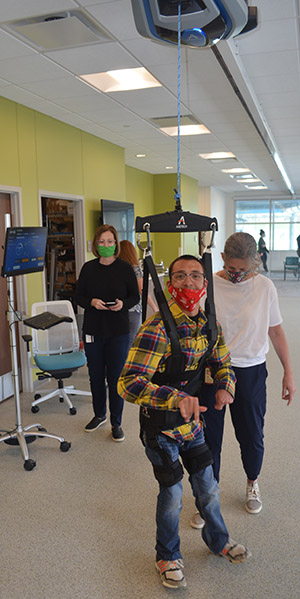The new Munroe-Meyer Institute building was created to be on the cutting edge of clinical care and therapy for individuals with intellectual and developmental disabilities, and one improved technology already is in use and garnering a positive response from therapists and clients.
The ZeroG Gait and Balance System includes a safety harness that runs along an 80-foot-long track in the mobility lab in the department of physical therapy, but it is far from a traditional body weight harness, said Sandra Willett, PhD, director of the MMI Department of Physical Therapy..
 |
The system runs on an 80-foot-long track in the mobility lab. |
“It would be more accurate to call it a robot,” Dr. Willett said. “It is fully programmable to provide weight relief, resistance and/or perturbations. It protects patients from falls while allowing them to explore new balance and mobility skills.”
In addition, she said, the system provides data collection for clinical outcomes “in a precise and comprehensive manner that we’ve never had access to before.”
Body weight support commonly allows clients with complex health care needs to try physical therapy exercises without fear of falling.
“But this actually senses what people are doing with their movement, so they can make some mistakes,” said physical therapist Amy Beyersdorf. “The expanded range gives them the confidence to try new things and to be more functional and intentional in their movements.”
Since the harness also is connected to a computer, the therapist can to control the level of support and track any falls or trips — with the system compiling a graph of data the therapist can consult during and after the session.
“It certainly gives you a lot more variability,” said physical therapist Heidi Reelfs. “Because the track goes for 80 feet, it allows for distance. But it also supports up-and-down movement, sit-to-stand transfers and more dynamic activities, such as kicking a ball or stepping over obstacles.”
The system also can be set to facilitate forward movement or, as a strengthening exercise, to provide resistance against moving forward.
Therapists also can initiate “perturbances” — resistance or support changes that the patient has to account for by reacting and keeping their balance.
“We haven’t had a way to do that in such a controlled manner before,” Reelfs said.
Jamie Gehringer, PhD, who oversees the Virtual Reality Laboratory at MMI, already is brainstorming ideas on how to marry the ZeroG device with his therapeutic gaming programs.
“This allows us another avenue to develop games that work on lower extremity skills, providing individuals a safe environment to do that,” he said. “Imagine you’re on the moon, and the body weight support can give you that sense of weightlessness. It greatly expands the range of skills we can work on, because the clients will feel a little more confident in the machine doing exercises such as squats or step-ups.”
“The clients will lead us to application,” Reelfs said. “Already, they are thinking of things to try in this system that go beyond my own list — and that’s fun to see, too.”
And that enthusiasm will result in therapeutic gains, Beyersdorf said.
“The real challenge, of course, is to improve function in every environment,” she said. “This is a powerful tool to help us reach that goal.”
